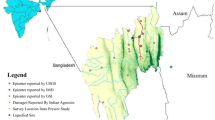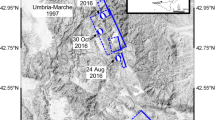Abstract
On January 24, 2020, Sivrice–Elazig–Turkey earthquake occurred along the East Anatolian Fault Zone. The moment magnitude of the event was reported as 6.8. This paper documents reconnaissance findings performed immediately after the event. Investigated sites namely, Lake Hazar shores, Karakaya Dam Reservoir–Euphrates River shores, Malatya–Battalgazi district and its villages, and Elazig Downtown are predicted to be shaken by rock peak ground acceleration, PGAVS30=1100 m/s, levels of 0.12–0.42 g, 0.05–0.11 g, 0.05 g, and 0.08 g respectively. The documented geotechnical field performances vary from widespread liquefaction-induced sand boils and lateral spreading, to no signs of surface manifestations of permanent ground deformations or soil liquefaction. In Battalgazi district and Elazig Downtown, the foundation performances vary from no signs of permanent ground deformations to 1–3 cm settlements, and 1–2 cm lateral movements. Additionally, the hydraulic structures inspected are estimated to be shaken by PGAVS30=1100 m/s levels of 0.03–0.23 g. Other than a minor longitudinal cracking along a limited section along the crest of a homogeneous earthfill dam, no apparent signs of permanent ground deformations were reported. Last but not least, a number of rock falls were mapped, based on back analyses of which probable peak ground velocities at these rockfall sites were speculated.








































Similar content being viewed by others
Abbreviations
- amax :
-
Maximum ground acceleration
- CB :
-
Correction factor for borehole diameter
- Cc :
-
Compression index
- CC :
-
Coefficient of curvature
- CE :
-
Correction factor for hammer energy ratio
- Cr :
-
Recompression index
- CR :
-
Correction factor for rod lenght
- CN :
-
Correction factor for overburden pressure
- CS :
-
Correction factor for sampling method
- CU :
-
Coefficient of uniformity
- CRRσ′v = 1 atm , M = 7.5, PL = 50% :
-
Cyclic resistance ratio adjusted to σ′v = 1 atm, M = 7.5, PL = 50%
- CSRσ′v,M :
-
Cyclic stress ratio at a given vertical effective stres and moment magnitude
- CSRσ′v = 1 atm , M = 7.5 :
-
Cyclic stress ratio normalized to 1 atm vertical effective stress for a M7.5 event
- dcrt. :
-
Critical depth
- D10 :
-
Paticle size corresponding to 10% finer on the cumulative particle size distribution curve
- D30 :
-
Paticle size corresponding to 30% finer on the cumulative particle size distribution curve
- D60 :
-
Paticle size corresponding to 60% finer on the cumulative particle size distribution curve
- FC:
-
Fines content
- FS:
-
Factor of safety
- KM :
-
Magnitude scaling factors
- Kσ :
-
Overburden correction factor
- M:
-
Moment magnitude of the earthquake
- N:
-
Measured standard penetration test blow counts
- N1,60 :
-
Normalized (overburden, equipment and procedure corrected) standard penetration test blow counts
- N1,60,CS :
-
Equivalent clean sand normalized standard penetration test blow counts
- PL :
-
Probability of liquefaction triggering
- PGA475 :
-
PGA for 475-year return period
- PGA72 :
-
PGA for 72-year return period
- PGAVS30 = 1100 m /s :
-
Median PGA for VS30 = 1100 m/s
- rd :
-
Stress reduction factor (aka: non-linear shear mass participation)
- S1 :
-
Coefficient factor for spectral acceleration at 1 s period
- SD1 :
-
Coefficient factor for design spectral acceleration at 1 s period
- SDS :
-
Coefficient factor for design spectral acceleration at short period
- SS :
-
Coefficient factor for spectral acceleration at short period
- VS12 :
-
Shear wave velocity of the upper 12 m
- VS30 :
-
Shear wave velocity of the upper 30 m
- σv :
-
Vertical total stress
- σv′:
-
Vertical effective stress
- σp′:
-
Preconsolidation pressure
References
Abrahamson NA, Silva WJ, Kamai R (2014) Summary of the ASK14 ground motion relation for active crustal regions. Earthq Spectra 30(3):1025–1055
Akkar S, Aldemir A, Askan A, Bakir S, Canbay E, Demirel IO, Erberik MA, Gulerce Z, Gulkan P, Kalkan E, Prakash S, Sandikkaya MA, Sevilgen V, Ugurhan B, Yenier E (2011) 8 March 2010 Elazig-Kovancilar (Turkey) Earthquake: Observations on ground motions and building damage. Seismol Res Lett 82(1):42–58
Akkar S, Azak T, Can T, Ceken U, Demircioglu Tumsa MB, Duman TY, Erdik M, Ergintav S, Kadirioglu FT, Kalafat D, Kale O, Kartal RF, Kekovali K, Kilic T, Ozalp S, Altuncu Poyraz S, Sesetyan K, Tekin S, Yakut A, Yilmaz MT, Yucemen MS, Zulfikar O (2018) Evolution of seismic hazard maps in Turkey. Bull Earthq Eng 16(8):3197–3228
ASTM International (2011) D2435/D2435M—11 Standard one-dimensional consolidation properties of soils using incremental loading. West Conshohocken, PA
ASTM International (2016) D7928-17 Standard test method for particle-size distribution (gradation) of fine-grained soil using the sedimentation (hydrometer) analysis. West Conshohocken, PA
ASTM International (2017a) D2487-17e1 Standard Practice for Classification of Soils for Engineering Purposes (Unified Soil Classification System), West Conshohocken, PA
ASTM International (2017b) D6913/D6319M-17 Standard Test Method for Particle-Size Distribution (Gradation) of Soils Using Sieve Analysis. West Conshohocken, PA
Boore DM, Atkinson GM (2008) Ground-motion prediction equations for the average horizontal component of PGA, PGV, and 5%-damped PSA at spectral periods between 0.01 s and 10.0 s. Earthq Spectra 24(1):99–138
Boore DM, Stewart JP, Seyhan E, Atkinson GM (2014) NGA-West 2 equations for predicting PGA, PGV, and 5%-damped PSA for shallow crustal earthquakes. Earthq Spectra 30:1057–1085
Boulanger RW, Idriss IM (2012) Probabilistic standard penetration test–based liquefaction–triggering procedure. J Geotech Geoenviron Eng 138(10):1185–1195. https://doi.org/10.1061/(ASCE)GT.1943-5606.0000700
Brandenberg SJ, Zimmaro P, Stewart JP, Kwak DY, Franke KW, Moss RE, Cetin KO, Can G, Ilgac M, Stamatakos J, Weaver T (2020) Next-generation liquefaction database. Earthq Spectra 36(2):939–959. https://doi.org/10.1177/8755293020902477
Cetin K, Seed R, Kayen R, Moss R, Bilge H, Ilgac M, Chowdhury K (2018) The use of the SPT-based seismic soil liquefaction triggering evaluation methodology in engineering hazard assessments. Methodsx 5:1556–1575. https://doi.org/10.1016/j.mex.2018.11.016
Cetin KO, Ilgac M, Can G, Cakir E, Soylemez B (2020) 24 January 2020, Sivrice–Elazig–Turkey Earthquake Reconnaissance Report. DesignSafe-CI. https://doi.org/10.17603/ds2-9jz1-e287.
Cheloni D, Akinci A (2020) Source modelling and strong ground motion simulations for the 24 January 2020, Mw 6.8 Elazig Earthquake, Turkey. Geophys J Int 223(2):1054–1068. https://doi.org/10.1093/gji/ggaa350
Chiou BSJ, Youngs RR (2008) Chiou-Youngs NGA ground motion relations for the geometric mean horizontal component of peak and spectral ground motion parameters. Earthq Spectra 24:173–215
Chiou BSJ, Youngs RR (2014) Update of the Chiou and Youngs NGA model for the average horizontal component of peak ground motion and response spectra. Earthq Spectra 30:1117–1153
Dakoulas P, Gazetas G (1985) A class of inhomogeneous shear models for seismic response of dams and embankments. Soil Dyn Earthq Eng 4(4):166–182
Duman TY, Emre O (2013) The East Anatolian Fault: Geometry, segmentation and jog characteristics. Geological Society London, Special Publications
Gulerce Z, Kargoiglu B, Abrahamson NA (2016) Turkey-adjusted NGA-W1 horizontal ground motion prediction models. Earthq Spectra 32(1):75–100
Gulerce Z, Tanvir Shah S, Menekse A, Ozacar AA, Kaymakci N, Cetin KO (2017) Probabilistic seismic-hazard assessment for East Anatolian fault zone using planar fault source models. Bull Seismol Soc Am 107(5):2353–2366. https://doi.org/10.1785/0120170009
Kale O (2019) Some discussions on data-driven testing of ground-motion prediction equations under the Turkish ground-motion database. J Earthquake Eng 23(1):160–181
Kale O, Akkar S, Ansari A, Hamzehloo H (2015) A ground-motion predictive model for Iran and Turkey for horizontal PGA, PGV, and 5% damped response spectrum: investigation of possible regional effects. Bull Seismol Soc Am 105(2A):963–980. https://doi.org/10.1785/0120140134
Kavruk F (2003) Seismic behavior of embankment dams. Middle East Technical University MSc dissertation
Kurtulus C, Sertcelik F, Sertcelik I, Kuru T, Tekin K, Ateş E, Apak A, Kokbudak D, Sezer S, Yalcin D (2019) Determination of the national strong ground motion recording stations’ soil parameters. National Earthquake Research Program (UDAP), AFAD (in Turkish)
Makdisi FI, Seed HB (1977) A simplified procedure for estimating dam and embankment earthquake-induced deformations in dams and embankments. Earthqukae Engineering Research Center Report No: UCB/EERC-77/19
METU EERC (2020) The Elazig-Sivrice Earthquake (24 January 2020 Mw=6.8) field observations on seismic and structural damage. Middle East Technical University Earhquake Engineering Research Center Report No: METU/EERC 2020–01
MTA (General Directorate of Mineral Research and Exploration) (2020) 24 Ocak 2020 Sivrice (Elazig) Depremi (Mw=6.8) saha gözlemleri ve değerlendirme raporu, Ankara. https://www.mta.gov.tr/images/duyuru_ek/belgeler/609_07-02-2020_2b82a14b.pdf(in Turkish)
Pousse-Beltran L, Nissen E, Bergman EA, Cambaz MD, Gaudreau É, Karasozen E, Tan F (2020) The 2020 Mw 6.8 Elazig (Turkey) Earthquake reveals rupture behavior of the East Anatolian Fault. Geophys Res Lett. https://doi.org/10.1029/2020GL088136
RocFall 2019 v7.0. (2019) Software for risk analysis of falling rocks on steep slopes. RocScience Inc., Toronto
Sandikkaya MA, Yilmaz MT, Bakir BS, Yilmaz O (2010) Site classification of Turkish national strong-motion stations. J Seismolog 14(3):543–556
Saroglu F, Emre O, Kuscu I (1992) The east anatolian fault zone of Turkey. Ann. Tectonicae VI:99–125
Saygili G, Rathje EM (2008) Empirical predictive models for earthquake-induced sliding displacements of slopes. J Geotech Geoenviron Eng 134(6):790–803. https://doi.org/10.1061/(ASCE)1090-0241(2008)134:6(790)
Seed HB, Idriss IM (1971) Simplified procedure for evaluating soil liquefaction. J Soil Mech Found Div 97(9):1249–1273. https://doi.org/10.1061/JSFEAQ.0001662
Seed HB, Tokimatsu K, Harder LF, Chung RM (1985) Influence of SPT procedures in soil liquefaction resistance evaluations. J Geotech Eng 111(12):1425–1445. https://doi.org/10.1061/(ASCE)0733-9410(1985)111:12(1425)
TBDY (2019) Turkish building earthquake code. Ministry of Interior, Ankara (in Turkish)
Tsuchida H (1970) Prediction and countermeasure against the liquefaction in sand deposits. Abstract of the Seminar in the Port and Harbor Research Institute (in Japanese)
Acknowledgements
The reconnaissance studies were supported by Middle East Technical University. The authors would also like to thank researchers who collaborated on field campaigns and data processing.
Funding
Funding was provided by Orta Doğu Teknik Üniversitesi.
Author information
Authors and Affiliations
Corresponding author
Additional information
Publisher's Note
Springer Nature remains neutral with regard to jurisdictional claims in published maps and institutional affiliations.
Supplementary Information
Below is the link to the electronic supplementary material.
Rights and permissions
About this article
Cite this article
Cetin, K.O., Cakir, E., Ilgac, M. et al. Geotechnical aspects of reconnaissance findings after 2020 January 24th, M6.8 Sivrice–Elazig–Turkey earthquake. Bull Earthquake Eng 19, 3415–3459 (2021). https://doi.org/10.1007/s10518-021-01112-1
Received:
Accepted:
Published:
Issue Date:
DOI: https://doi.org/10.1007/s10518-021-01112-1




